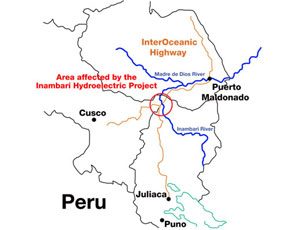Brazilian-backed proposal to build a 2,000-megawatt hydroelectric plant in the Peruvian Amazon has gained momentum in recent weeks as the government of the Andean nation has thrown its weight behind the effort.
The Brazilian consortium behind the $4-billion project, Empresa de Generación Eléctrica Amazonas Sur S.A.C. (EGASUR), is expected to present feasibility studies for constructing the hydroelectric plant on the Inambari River to Peru’s Ministry of Mines and Energy early this month.
EGASUR is composed of Brazilian construction firm OAS as well as the country’s national electric utility company, Eletrobras, and its subsidiary Furnas. MEM granted the consortium a two-year concession to develop the studies for the project in June 2008.
Peruvian President Alan Garcia, after meeting on Feb. 2 with EGASUR representatives, said they were prepared to begin work by the end of the year.
Construction on the proposed powerplant is expected to take at least four years. When completed, Inambari would be almost twice the size of Peru’s largest current hydro facility, the 1,008-MW hydroelectric complex on the Mantaro River in the central highlands.
The Inambari project marks Peru’s largest hydropower investment. In the past three decades, Peru has invested $6 billion in hydroelectric schemes, and the country’s installed capacity is approximately 6,500 MW.
The governments of Peru and Brazil signed a preliminary agreement for the construction of the dam in April 2008. According to the agreement, as much as 75% of the power from the facility initially would be routed eastward to meet the needs of Brazil’s electrical grid. Over time, the power from Inambari would increasingly be rerouted to meet Peru’s electrical demand, with the surplus going to Brazil.
The Inambari effort is just one of a half-dozen similar Brazilian-backed projects with a combined total estimated at $16 billion.
Brazil has sought new international sources for power after renegotiating an agreement with Paragruay for power from the 14,000-MW Itaipu hydroelectric facility on the Parana River. Itaipu provides 20% of Brazil’s electricity needs, and the new contract almost has tripled costs for power.
Opposition on environmental grounds has been growing. Local residents have staged protests in recent weeks. Peru’s environmental ministry supports the scheme, although the country’s environmental agency INRENA described the project as an “inefficient and unsustainable use of water resources” as recently as 2007.
Initially, the government estimated 175 square miles of rainforest would be inundated but later revised the figure to half that amount. Currently, MEM estimates at least 3,300 people would be displaced by the flooding.
One of the key concerns about the project has to do with another big-ticket infrastructure effort it would imperil: the $1.3-billion InterOceanic Highway across southern Peru. The reservoir of the proposed dam would flood as much as 120 kilometers of the roadway at the most difficult section for construction.
When completed later this year, the InterOceanic Highway will be the final link in a mid-South American ocean-to-ocean roadway. Two consortiums led by Brazilian construction giants Odebrecht and Carmargo Correa are building the highway, and both hold 25-year contracts to maintain and operate the road. If the Inambari hydroelectric project is green-lighted, officials say the contract to construct it will include provisions for building a new route for the highway.




Post a comment to this article
Report Abusive Comment